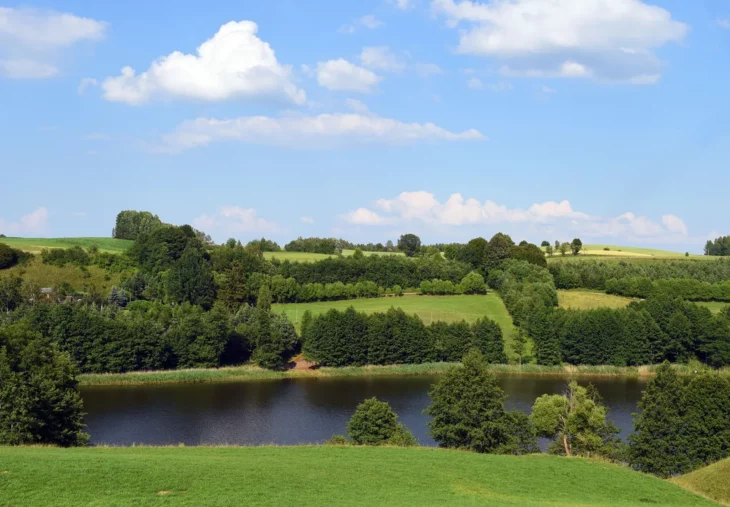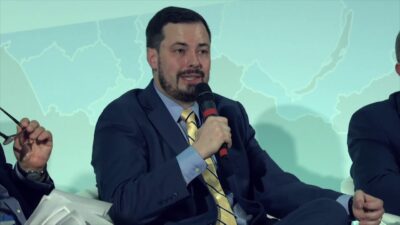
In a showdown between Russia and NATO, the ‘Suwałki Gap’ would likely be the first point of contact.
Strolling amid the ornate 19th-century villas, fountains and lakes that dot this sleepy spa town, it’s easy to forget that you’re standing in Vladimir Putin’s crosshairs.
Nestled on Lithuania’s southeastern border, Druskininkai opens onto a narrow notch of strategic territory known as the Suwałki Gap. Stretching about 100 kilometers along the Lithuanian-Polish frontier, between Belarus in the east and the Russian exclave of Kaliningrad to the west, Western military planners warn the area would likely be one of the Russian president’s first targets were he ever to choose to escalate the war in Ukraine into a kinetic confrontation with NATO.
You wouldn’t know it by looking at it — and that, say Eastern European officials seeking to draw attention to the Western military alliance’s vulnerabilities in the east, is at the heart of the problem.
Druskininkai, a town of about 12,000, is no stranger to either Russia or to the tumult of European history,
Designated an official spa for Russian civil servants by Czar Nicholas I in 1837, the town’s mineral-rich waters have drawn visitors from around Central and Eastern Europe ever since, even as invading armies — Prussian, Polish, Russian, Soviet — shifted control of the region between them.
During the Cold War, the resort was a favorite Soviet holiday destination. Today, it’s home to one of the world’s largest indoor snow arenas and an elaborate water park. And until the war in Ukraine put it out of reach, it had lost little of its allure for Russians, who along with Belarusians, accounted for the largest percentage of visitors.
That familiarity might explain why some locals are sanguine about the prospects of an invasion. “We don’t live in that fear,” Danukas, a 22-year-old who grew up in Druskininkai, said on a recent afternoon. “If it happens, yes, people will be wondering but right now that’s not really the case.”
Danukas, who asked that his full name not be used in order to protect his privacy, said he was confident that NATO would protect Lithuania, a country of 2.8 million. If it doesn’t, he “would just go out of the country,” Danukas said, adding that the military “wasn’t his thing.”
A recent visit down a lonely road lined with pine trees to the border with Belarus, just 10 kilometers from the center of town, suggested it might be wise to pack a bag. The border post, one of two near the town, was closed and deserted, with neither soldiers nor border patrol anywhere in sight.
In fact, on a daylong journey across the Lithuanian side of the Suwałki corridor, a rural landscape of small farms, rolling fields of buttercups and forest, this reporter didn’t see even one military vehicle or soldier.
“The community trusts in the Lithuanian military and NATO and in their capacity to ensure safety,” the town administration said in a written statement (The mayor has been away on vacation).
Ramūnas Šerpetauskas, who commands a local company of Lithuania’s Riflemen’s Union, a voluntary militia with roots stretching back more than a century, said that all remained quiet on Lithuania’s eastern front so far. While he said he didn’t expect Russia to try anything for as long as it had its hands full in Ukraine, he added that he and his comrades were monitoring the situation in the border region, calling the the Suwałki Gap Lithuania’s “Achilles heel.”
“Some think there’s no point to attack us, but it must be noted that this is a direct land route to Kaliningrad,” he said. “If they are able to overcome Ukraine, it is possible that the next blow would fall here.”
The latest reminder of the tightrope Vilnius is walking with Moscow came over the weekend as Lithuania’s national railway said that in order to comply with European sanctions, it would no longer permit the transit of certain goods across the country’s territory from Belarus to Kaliningrad, including coal, metals and building materials.
“We consider this to be a most serious violation,” Kaliningrad’s governor, Anton Alikhanov, said in response to the move, which he said would effect up to half of Russian exports to the exclave.
‘The Baltics will be next’
Former Estonian President Toomas Hendrik Ilves said he came up with the name “Suwałki Gap” minutes before a meeting with then-German Defense Minister Ursula von der Leyen in 2015 in an effort to raise alarm about the hole in Western defenses.
The worry is that in a conflict with the West, Russia could sweep into the corridor simultaneously from the east and the west, severing the European Union’s Baltic countries from their allies to the south. “It’s a huge vulnerability because an invasion would cut off Lithuania, Latvia and Estonia from the rest of NATO,” said Ilves.
Such a move would also result in an immediate faceoff between Moscow and NATO’s nuclear-armed members, pushing the world to the brink of world-ending confrontation.
Ilves’ warning to von der Leyen, now president of the European Commission, was a reaction to Russia’s annexation of Crimea the year before, but his doomsday scenario has gained new credence in the wake of Putin’s latest invasion of Ukraine.
Just as Putin is trying to create a land bridge between Russia and the Crimea peninsula, taking the Suwałki Gap, which is named for a prominent town on the Polish side of the border, could link Russian troops in Kaliningrad, a key Russian outpost, with those stationed in its de facto protectorate Belarus.
In Kaliningrad, Russia has built a formidable military presence, spanning nuclear weapons, its Baltic fleet and tens of thousands of soldiers. (The exclave, which has a population of nearly 1 million, was German territory until after World War II, when it was known as Königsberg. The Soviet Union wrested control of the region from Germany after the war, renamed it Kaliningrad and expelled the German population.)
While there’s no reason to suggest an attack is imminent, the Russian leader appears to delight in keeping the West guessing what his next move will be. Earlier this month, he praised the imperial exploits of Peter the Great, declaring that “a country is either a sovereign or a colony,” comments that did little to reassure the Baltics. Mikhail Kasyanov, a former Russian prime minister under Putin, added more fuel to the fire last week, predicting that “the Baltic states will be next” if Ukraine falls.
The expected NATO accession of Sweden and Finland has further raised tensions between Russia and the alliance. The addition of the two Scandinavian countries might make it more difficult for Russia to sever the Baltics from the rest of the alliance, but it would also turn the Baltic Sea into what some are calling a NATO lake, perhaps giving Moscow even more of an incentive to build a bridge to Kaliningrad.
Sweden’s and Finland’s inclusion in NATO makes a Russian move “less likely, but that doesn’t mean it’s unlikely,” said Linas Kojala, the director of the Eastern Europe Studies Center, a Vilnius-based think tank.
Eastern alliance
Despite the Baltics’ strategic concerns, what may be the most dangerous thing about the Suwałki Gap is its relative irrelevance.
A move by Russia on Poland or Lithuania would clearly trigger NATO’s Article 5 mutual defense provision, immediately pulling in all the alliance’s members — from Turkey to Bulgaria to France and the United States.
At least in theory. How eager would Washington and NATO be to risk Armageddon over a stretch of largely unpopulated farmland few of their citizens even know exists? It’s exactly the kind of edge case that Putin has proved eager to test.
Until (and if) Finland joins, Lithuania’s 900-kilometer border with Russia and Belarus is the longest in the alliance. But with an army of just 20,000 and an air force with only five planes including transport aircraft and one single-engine Cessna, Lithuania, like its Baltic neighbors, is ill-equipped for a Russian assault — even with help from the German-led battle group currently stationed in the country.
“The only answer to that challenge is an increased NATO presence here,” said Margiris Abukevičius, Lithuania’s vice minister of defense. “We know how Russia is obsessed with closing land corridors.”
During a visit to Vilnius earlier this month, German Chancellor Olaf Scholz tried to reassure his hosts of Berlin’s commitment to Baltic security but ended up sowing confusion. Scholz told reporters that Berlin would move “in the direction” of stationing “a robust combat brigade” in Lithuania, implying several thousand troops would be deployed. His aides later walked back the comments, saying that Germany would only move the unit’s headquarters — around 50 personnel — there, while the majority of the troops would remain in Germany.
As NATO prepares for what many observers say will be its most important summit in decades later this month, the exposure of the Baltics to Russian aggression is at the center of deliberations over whether to station more alliance troops in the region on a permanent or semi-permanent basis.
While the U.S.-led alliance has yet to take a final decision, officials have signaled that NATO would significantly bolster forces in the Baltics and elsewhere along the EU’s eastern frontier, heralding a historic shift in NATO posture and shifting the pact’s center of gravity to the east.
Though NATO has four 1,000-strong battle groups stationed across the region, Baltic political leaders and military planners argue that much more would be needed to deter Russian aggression.
“You have a so-called trip-wire force, but you may as well call it a suicide mission,” said Ilves, who served as Estonian president from 2006 to 2016.
The U.S. and Germany long cautioned against such a move, in part because of a 1997 accord, known as the NATO-Russia Founding Act, in which the alliance agreed with Moscow not to establish permanent bases in new member states in “the current and foreseeable security environment.” Russia’s attack on Ukraine, however, has convinced even longtime skeptics of what NATO calls “forward defense” in Eastern Europe that the time has come.
“I’ve changed my mind,” said Ben Hodges, a retired American lieutenant general who commanded the U.S. Army in Europe from 2014 to 2017. “Our good faith efforts to engage with Russia have failed.”
In Belarus, over which Putin has recently asserted more influence, the Russian military has recently used air bases and other military infrastructure to launch assaults on Ukraine.
Hodges said he doubts whether Russia, which is struggling in Ukraine, could muster the capabilities it needs to attack the Baltics for now. But he said it was essential for NATO to use this opportunity to prepare for the worst, including by bolstering the Baltics’ air defenses and ensuring better integration between local forces and the rest of the alliance. He said he could envision a system with a “rotating permanent presence” of NATO forces in the region, similar to how the U.S. operates in South Korea.
Another key factor in the region’s defense is Poland, which has the largest military in the region. Historic disputes between Poles and Lithuanians in the Suwałki corridor over language and minority rights on both sides of the border have led to speculation that Putin could use those tensions to his advantage, similarly to his tactic in Donbas, where he succeeded in harnessing pro-Russian sentiment to unleash a separatist movement.
That has yet to happen. Cross-border cooperation between the Polish and Lithuanian militaries has never been closer, according to General Rajmund Andrzejczak, Poland’s top military commander.
“We see what the Russians are doing in Ukraine, so we don’t trust them,” said the general, who once served in the Suwałki region, stressing that Poland was prepared to honor its alliance obligations towards Lithuania if Russia moves in.
“We have to be very, very ready,” he said.
Jurgis Vedrickas contributed reporting to this article.




